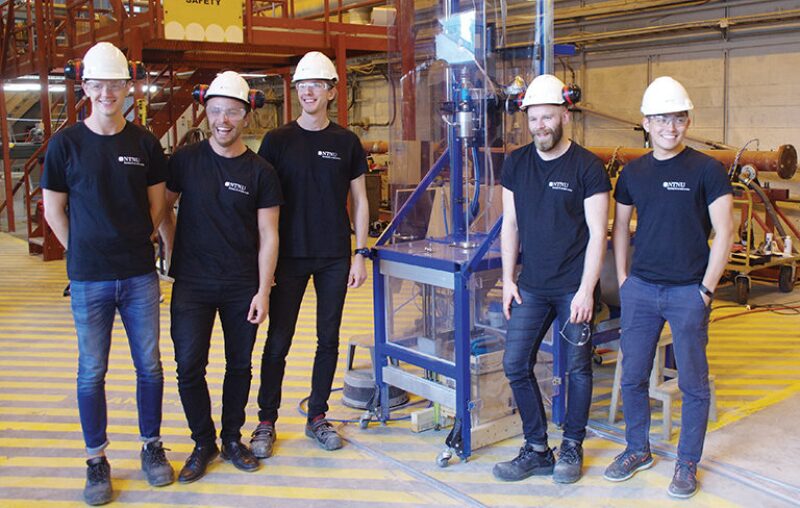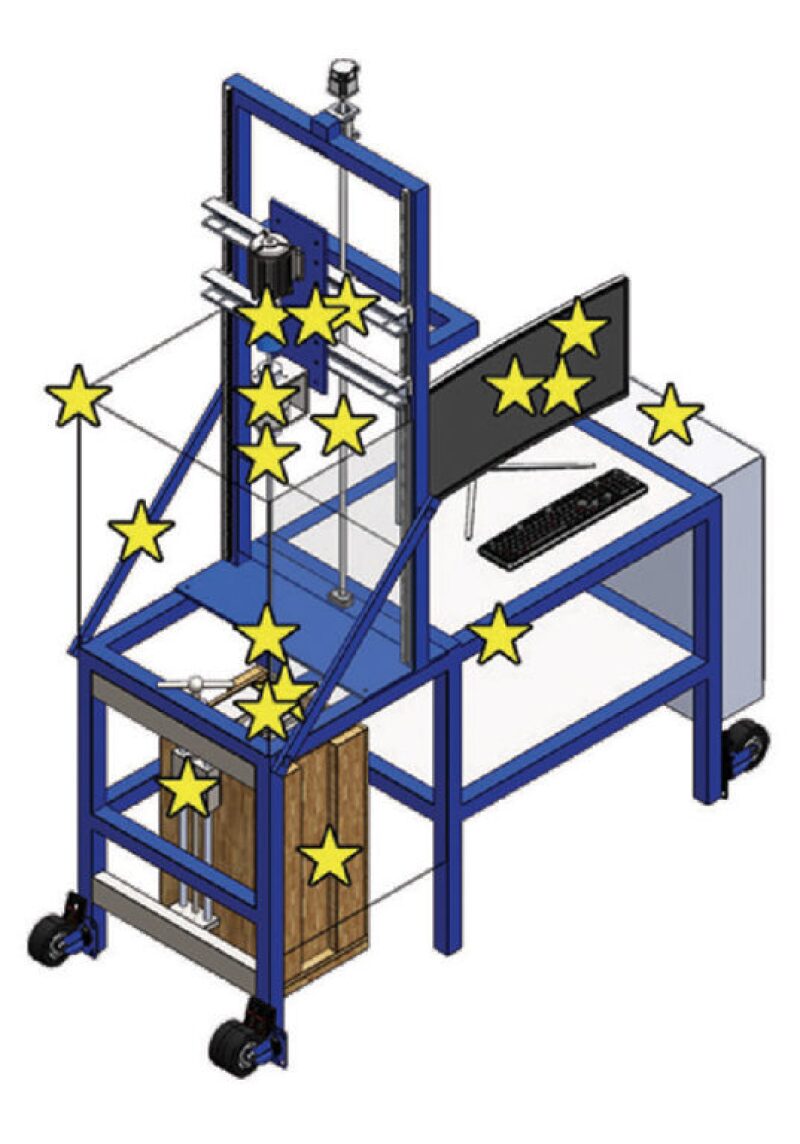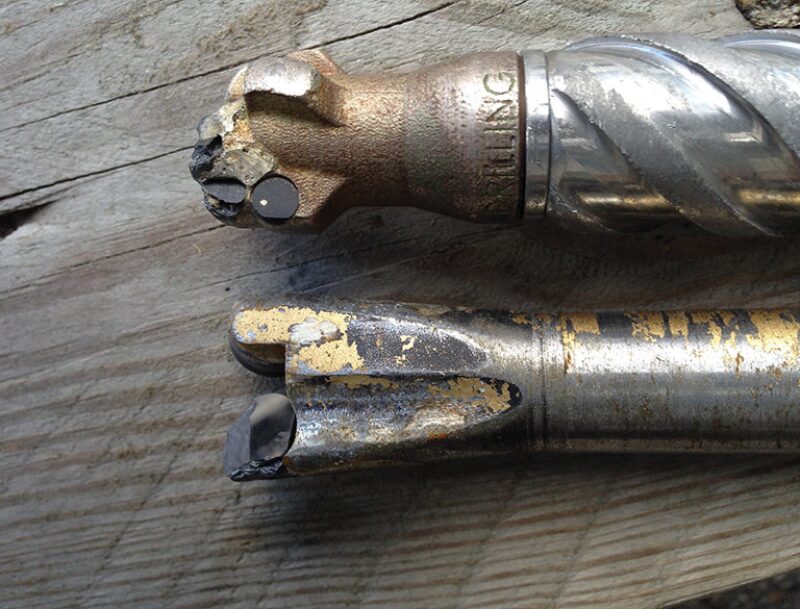There is not a big difference between those two drill bits. Both have fixed cutters and show some wear.
If they look small, that is perceptive. They were used on the automated drilling rigs, which are the scale of machine tools, built by student teams for the Drillbotics competition.
The one on the top was designed by the team from the Norwegian University of Science and Technology (NTNU), which was the first to design its own fixed-cutter bit in the competition put on by SPE’s Drilling Systems Automation Technical Section (DSATS).
The difference is in the polycrystalline diamond cutters (PDC), and it is not a big one. The ones on the student-designed bit (top) have a lower profile than the one (bottom) provided to all the competitors for free by Baker Hughes, a GE company.
Varying the cutter size and angle to change how much rock a bit breaks off per rotation are common design options. When John Macpherson, a senior technical advisor for Baker Hughes and a former DSATS chair, saw it, he said: “It looks like a normal PDC bit.”
What made that small difference worth noting are the things the NTNU team did to turn it into a significant advantage.
“Even though the designed drilling bit may look like the most important element, it was a combination of a number of factors that allowed them to enlarge the (performance) envelope and drill much faster,” said Alexey Pavlov, a professor of petroleum cybernetics at NTNU who was the faculty advisor on the project.
The challenge faced by these teams building something that looks like drilling in miniature is a fundamental one facing engineers building and running drilling machines at a time when the word drilling is married to the word system.
Performance will vary based on how well the parts, and people in different disciplines, work together. “Those in drilling need to understand these are systems, not just mechanical devices,” Macpherson said.
“We originally started here building mechanical tools with a mechanical engineering group. Then we brought in electronics, software, physics modeling and so on, and now we have a drilling systems engineering group.”
That cooperative, multidisciplinary approach required by Drillbotics “very much mirrors (and perhaps leads) real-world approaches,” he said.
That complicated stew of the variables attracted Sebastian Knoop, the NTNU student who was the first to volunteer for the university’s Drillbotics team, which was one of their Master’s project options.
“Drillbotics was the one I found really interesting. It was a competition. That is the one that lit me up. The mix of drilling, robotics, and automation got me into it,” he said, adding, “I was the first one on the team, then some of my friends got in it as well.”
Significantly, they also recruited a “guy not from the same petroleum engineering gang as the rest of us,” he said. That recruit, Mikkel Leite Arnø, majored in industrial cybernetics and provided critical robotics expertise. They were heeding the advice from the Drillbotics judges to the 2017 NTNU team to “try to establish a multidiscipline team next year.”
Ready for Surprises
The big difference between a programmable drill press and a Drillbotics rig is in what they are drilling through. A modern machine tool is powerful and precise enough to drill a hole in a piece of steel to exact specifications. That is not easy but the problem is predictable.
Student drilling rigs are built to drill into a test block. On the day of the competition, they receive a wooden box hiding their block. Like full-scale rigs, their automated drilling machine must react to unexpected things inside this approximation of a formation. Based on previous competitions they should know they will need to build a machine able to react fast to nasty surprises.
The blocks were built in the garage of Fred Florence, a former DSATS leader who more than anyone else started the competition. He is a creative person whose interests include drawing and building blocks with hazards he describes as “evil.” Over the years the competition blocks have been built with severe dips that can cause the bits to drift, or a combination of asphalt and a rubber floor to simulate other hazards.
The judge’s notes on the performance of the NTNU team, which finished second in 2017, noted “there was some confusion when the drilling stopped when the bit encountered the rubber.”
Obstacles loom large because Drillbotics rigs cannot power past them. The contest rules build a weak link into all these systems—a thin aluminum pipe that stands in as the drillpipe. In year one of the competition, every system failed before reaching bottom when the rigs hit a hard patch that caused the pipe to twist off. Their laptop-based control systems simply could not react fast enough.
In the 2018 competition, all the teams got through the block, and all of them had downhole sensors that failed. Data from the sensor, which was required for the first time in 2018, will be needed to steer the bottomhole assembly in future competitions. Teams building machines for the 2019 competition are the first to be required to drill directionally.
Advances are a product of one of the least glamorous foundations of engineering success—systematic preservation of institutional knowledge.
The NTNU team received a master’s thesis written by the previous team, which had come in second in the first time the university entered. That paper can be found online at the Drillbotics website along with previous design reports and student presentations. SPE papers written by past winners can be found in OnePetro.
Institutional knowledge management skills vary. “Some teams are run like a business with notes available to the next set of students,” Florence said. He said the goal is to promote information sharing to “accelerate learning, more in line with academic processes, rather than industry practices that seem to keep such information proprietary.”

Taking a Leap
Inheriting a drilling rig from a team that placed second seems like a big edge. The new NTNU team had a short hand-off meeting with their predecessors, and then they began changing things.
“We found it (the drill rig) was really difficult to use on a day-to-day basis. It was unpredictable,” Knoop said. The first priority was to find ways to bolster the structure to reduce vibration—a common problem for Drillbotics competitors.
And they began considering a big leap—designing their own drill bit. Their analysis showed that lowering the profile of the blades could reduce the torque to a fraction of what it would be if they used the competition bit. It could cut less per rotation, but it allowed them to drill faster by adding more weight on the bit and increasing the rotations per minute without the big increase in torque they would get from the competition bit.
The NTNU bit was designed by team member Alexander Handeland, who created the engineering drawings with inputs from the others whose work would need to reflect the design.
Other Drillbotics teams had failed to make a bit that outperformed the competition bit. Clausthal University of Technology built a bit that hammered the rock. They patented it for use in geothermal drilling, but it did not offer an edge in the competition, Florence said.
Rather than try to make a bit, the NTNU team started looking for a supplier willing to make a little custom bit for a price that fit within the competition’s $10,000 budget limit.
An NTNU faculty member who used to work for Lyng Drilling connected them with the small Norwegian drill bit maker owned by Schlumberger. Knoop said they toured its plant and reached a deal with Lyng to build their bit. The dollar value of the work, which was donated, fit within the team’s budget,he said.
The order was placed early in the second semester as the team joined the mad rush of Drillbotics teams building, programming, and testing machines around their school work.
During the long wait for the bit, team members built and tested their revised system, nervously hoping their engineering assumptions would prove to be correct.
For testing they used a bit ordered from the Chinese online market, Alibaba, which was closer to the cutter profile they designed than the competition bit. But without the actual bit, they were “not completely sure of what the end result will be,” Knoop said.

Guessing Game
Creating a drilling system magnifies the number of things that can go wrong. Extensive testing showed the value of the “nonaggressive” drill bit. But creating a control system to realize that advantage was a scary process.
In theory, the change would really simplify drilling control. Instead of programming a controller to try to regulate something as volatile as torque, less-aggressive cutters allowed them to focus the programming on putting more weight on bit, which is easier to manage and ensures faster drilling.
They still had to keep an eye on torque. If it spiked to dangerous levels, they needed an automated system able to react really fast. They did that by installing a communication system that was 10× faster (10 Hz to 100 Hz), and redesigning the control system to keep up, Knoop said.
The team divided work along functional lines. Mikkel Leite Arnø and Andreas Thuve were responsible for programming the new control and data systems. They began by taking an online course to learn the software used in the system. After developing the control program, they spent months getting it to work.
The fast-response control system upgrade only began working dependably a few days before judging. A software bug that caused the control system to keep buckling the drillpipe was fixed the day before it, after they found a post on an online forum that pinpointed the bad code and how to fix it, Knoop said.
There were also big questions about the new bit. Most of the testing was based on the bit from Alibaba. The Lyng bit arrived late in the process and they did not want to batter it by drilling through the granite blocks they used for testing, which are literally hard on drill bits.
“If you ask if we were sure it would work—the answer is no. That’s the whole thrilling point of the competition,” Pavlov said.
Drillbotics 2019ImageNew Challenge: Experienced teams will build a directional drilling machine. New teams will compete using the 2018 rules. Teams: 11 universities Judging: Teams will compete at the venue nearest their university: Celle, Germany, and in Houston. Rock: Initially the test block will be sandstone. In future years, obstacles will again be included. New teams will use a block similar to last year’s and drill vertically. Path: Those drilling directionally will drill down and turn, exiting the side of the block near the bottom. Etc: The drill bit will be slightly larger (⅛ in.), and the drillpipe and connector will be stronger in the directional challenge. For more information, see www.Drillbotics.com. |
Test Day
Soon after Thuve, the drilling operator, pushed the start button on judgment day at NTNU—4 June—something went wrong. “The downhole sensor, which worked fine a few hours before while drilling a pilot hole, stopped communicating to the surface,” Knoop said.
Drilling blind did not seem to matter. “What happened is that the rig rushed through the first layers of sandstone and pebbled cement, with an astonishing rate of penetration,” Knoop said.
Then it hit a wall—actually a tile placed at a 45° angle—and froze.
“Our theory is that our impact slightly shifted the inclined tile downwards, thus locking the drill bit like a wedge,” he said. The torque surged to a level that risked buckling the pipe. Thuve “was millimeters away from hitting the emergency stop button. However, our control system reacted as intended by pulling up the bit, thus releasing the built-up torque,” Knoop said.
“Once the torque level dropped down, rotation commenced again, and the rig added weight and continued drilling. This was an intense moment, lasting maybe for 2–4 seconds,” he said.
From there they drilled far faster than they had expected, finishing in under 4 minutes based on Florence’s cautious estimate, or 3 minutes and 15 seconds, ac-cording to the team’s estimate. Either way it was a fraction of the 15-minute average for the other teams, which included past champions, The University of Oklahoma and Texas A&M University, which finished second and third, respectively.
NTNU was clearly faster, but Florence and the other judges also evaluated the quality of the engineering work to see if they were good, as well as a bit lucky. “They really understood the entire problem. That is one of the big reasons (they won), not just drilling quickly,” Florence said.
He later wrote: “They studied the bit/rock interaction via offline testing. They calculated the reactive torque acting on the thin-walled aluminum tubing that DSATS forced them to use. They made an informed decision to drill a little bit slower, knowing this would increase their ability to avoid pipe damage. They fully understood the concept of trade-offs that affect nearly every engineering decision.”
Judges gave the NTNU high marks for creating an improved pipe connection, good division of labor, their knowledge of drilling problems and how to overcome them, and their system’s ability to automatically generate a drilling report minutes after finishing.
And they were a bit lucky. Their engineering assumptions were up to the challenges hidden inside. The tilted tile presented a challenge, but not a new one. The previous NTNU team had successfully drilled through an angled tile as well. Florence said “the surprise was there was no surprises.”
Pavlov said Drillbotics provides useful lessons ranging from learning to be a “multidisciplinary specialist with systems thinking” to dealing with a project that requires managing risk, raising money, and working with suppliers.
Moray Laing, director of digital solutions for drilling at Halliburton, said they did what “a really good drilling engineer with enough time would do. Is this a new bit game-changer? Probably not, but the concept of systems thinking is the skill set we’re looking for. And the unbiased approach to problem solving (unfettered by current knowledge) is what we look for,” he said.
After years of study, their ideas got a real-world test. Florence said, “You learn a ton building one.”
And Knoop, who is now a field engineer for Altus Intervention, said, “I felt I learned the most about managing a project, being on a team, and working together.”


